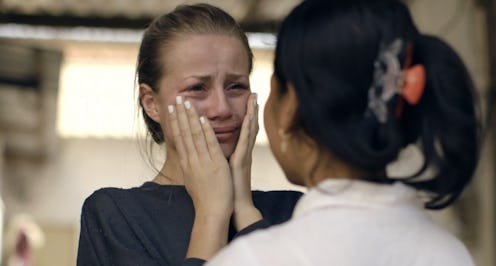Fashion
Norwegian TV Series Sends Bloggers to Sweatshops

It may not be a huge surprise to most that sweatshops and underpaid (or sometimes trafficked laborers) are involved in the production of the clothes on our backs. It's one of those facts that we tend to overlook in exchange for a trendy shirt that costs less than $10. Recently, the Norweigian television series Sweatshop sent three fashion bloggers to work in a sweatshop in Cambodia, and even though they vaguely knew about the conditions under which their clothes were made, the unfairness of it all didn't really hit them until they were standing in front of the sewing machines.
Remember the premise of the movie Zoolander? The evil guy, Mugatu, played by Will Ferrell, was in legal trouble because he was using children in Malaysia to make his clothes for unfair wages. Derek Zoolander, played by Ben Stiller, and his lawyer, Matilda Jeffries, played by Christine Taylor, teamed up with free-hug model Hansel, played by Owen Wilson, to uncover what Mugatu was doing with his new line. Not to spoil it for those who haven't seen it, but in the end, both child labor and unfair wages were deemed illegal. Mugatu also got in trouble for other stuff, like stealing credit for that awful piano tie. It might have been a silly film, but all the issues they touch on are actually very serious in real life — issues I'm glad are getting even more attention every year.
The fashion bloggers, Annikan, Frida and Ludwig all had their own speciality when it came to the style world. They didn't know each other prior to the trip, but were forced to spend a week together in Phnem Penh, Cambodia where the majority of the town is made up of garment workers. I recently sat down and watched the entire series; it's definitely a tough thing to digest, but absolutely worth checking out.
The Bloggers
Annikan
She was definitely the most emotional throughout the trip, but rightly so. Annikan hosts one of the most popular fashion blogs in Norway. Before leaving on the trip, she said she was going to learn more about the garments she posts on her site — and she certainly did.
Frida
Never without her trademarked winged eyeliner in Cambodia, Frida let the injustice turn to personal anger. She was fired up about the unfairness she was seeing in the garment district. Her blog in Norway is not as popular as Annikan's but she knew more about sewing, so had a better understanding of how difficult a job these underpaid workers were doing.
Ludwig
Ludwig is known by his friends for traveling the world and coming back with cheap, ethnic clothes from wherever he went that week. While on the trip, Ludwig got this tattoo in "an attic in Phnem Penh." It is a price tag on a sweater sold at a typical clothing store in Cambodia. It also is the same amount as one month's salary for a garment worker.
The Plot
The bloggers only worked in the sweatshop for one day. They worked eight hours, when a typical week-day work shift is 12 hours. All three were put in front of a sewing machine and sewed the same seam all day. Later, they would meet a girl who would have sewn the same seam for 14 years.
At first, the bloggers don't think their situation was "that bad." They workers sit all day, when many of them don't have chairs at home, and their job is not physically exhausting. It was not until a trip to the grocery store and market to try to make a 10-person dinner with $3, a typical day's earning for a garment worker, did they realize how unfair the wages really were.
Since I first really learned about human trafficking my senior year of high school, I've been passionate about international injustice. That same year, I stopped eating chocolate made my certain brands because I found proof they used trafficked laborers to pick the cocoa beans. The sacrifice may not make a huge difference in the scheme of things, but it was something I could do.
I feel the same about this series. It was a very tame look into how garment workers live in Cambodia, but it will start conversations. The series, in fact, warns you that it is not even a portrayal of how bad a typical sweatshop can be because the shop the fashion bloggers worked in was the only one that accepted them to come work. When Ludwig found that out, he admitted he was afraid to see what the places that turned them down actually looked like.
It really is because of these workers that our clothes can be as cheap as they are. Major fashion brands have since taken action regarding the workers they use in this area, but obviously not enough has been done if garment workers are holding protests are being held in Cambodia nearly every month. I can't imagine waking up, going to work for 12 hours a day, sewing the same seam, then going home and repeating the same thing the next day — until I died. Additionally, I can't imagine doing that for $3 a day, then being expected to provide for my family.
As far as what we can do, it's time to research clothing companies before we buy. It'll probably mean you spend a little more on your wardrobe. Saving up for a week to buy a slightly more expensive (but ethically made) dress might not seem like much, but ever little bit make a difference. Plus, from personal experience, I can tell you it feel really, really good to know that each hand that touched my new garment before me was treated and paid properly while they made it.
You can watch the series here (it's in Norwegian, but there are English subtitles). It's definitely worth a viewing.
Images: Sweatshop